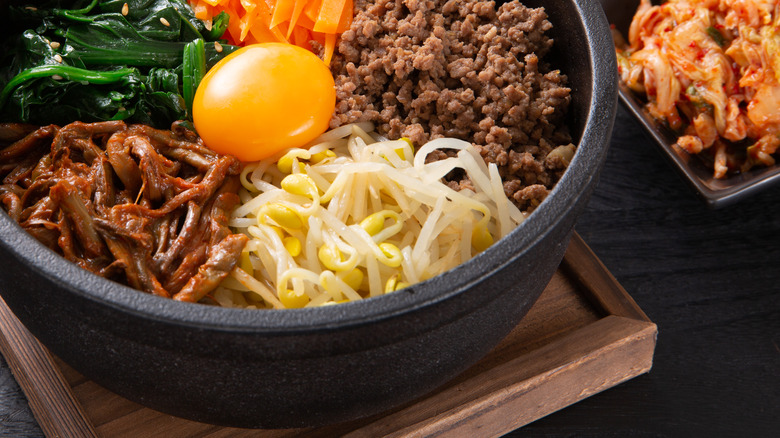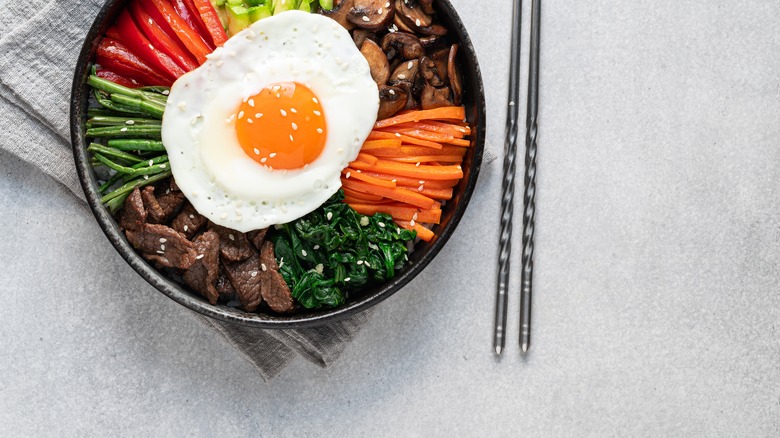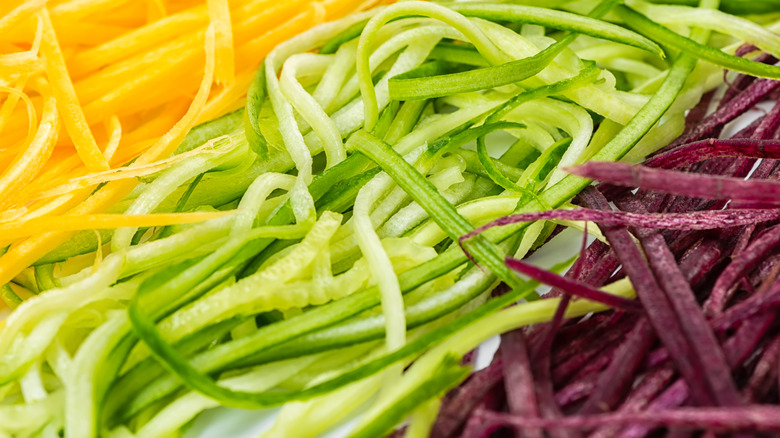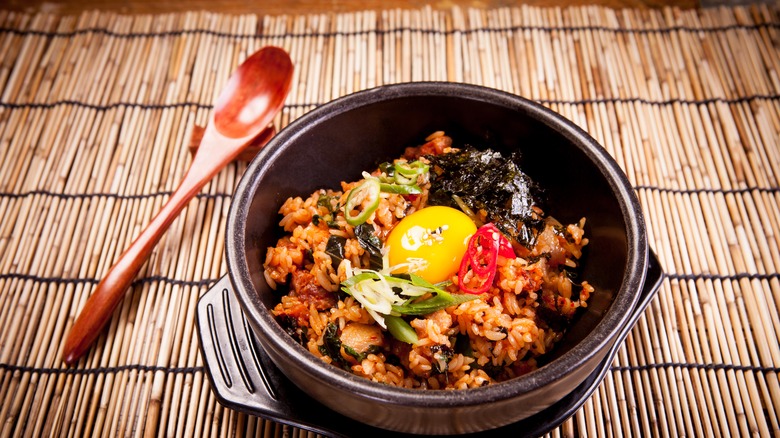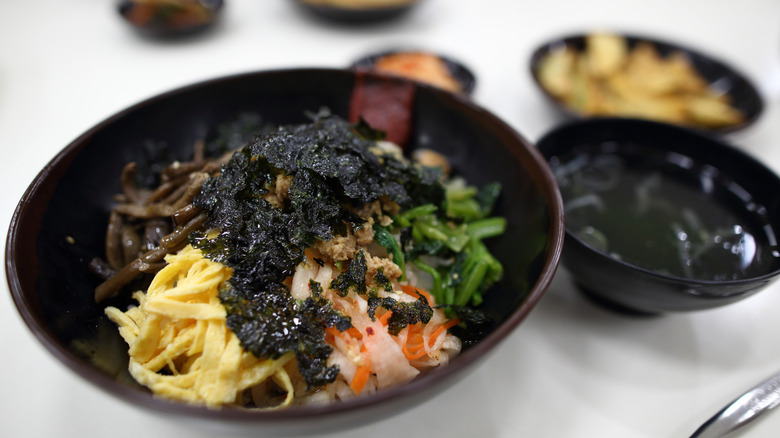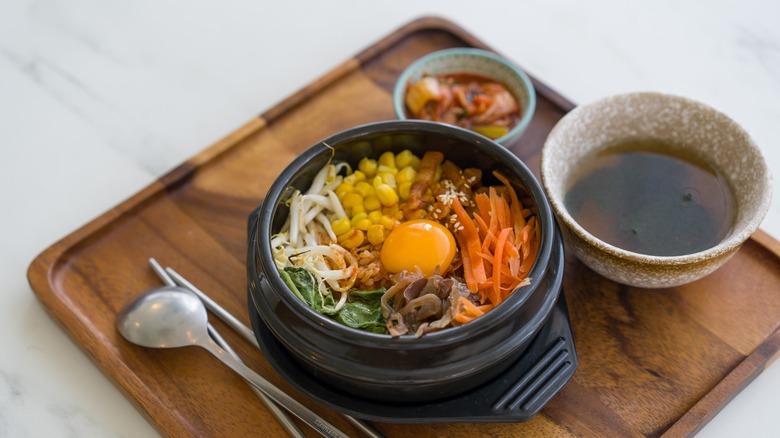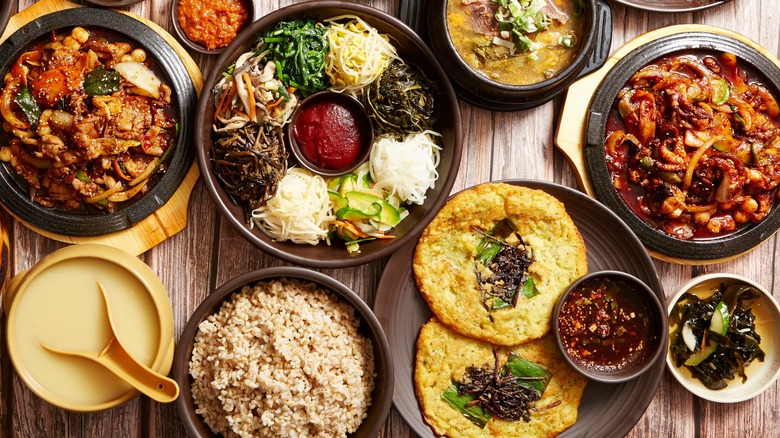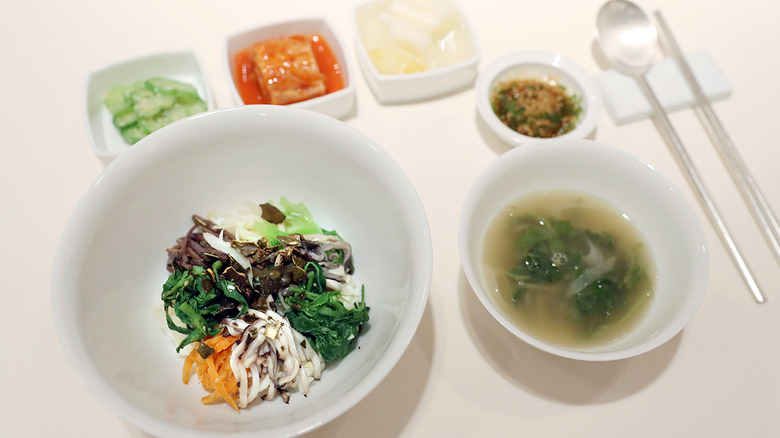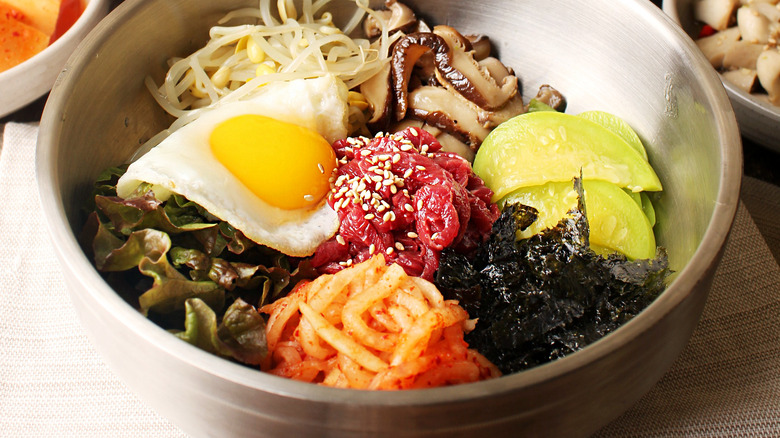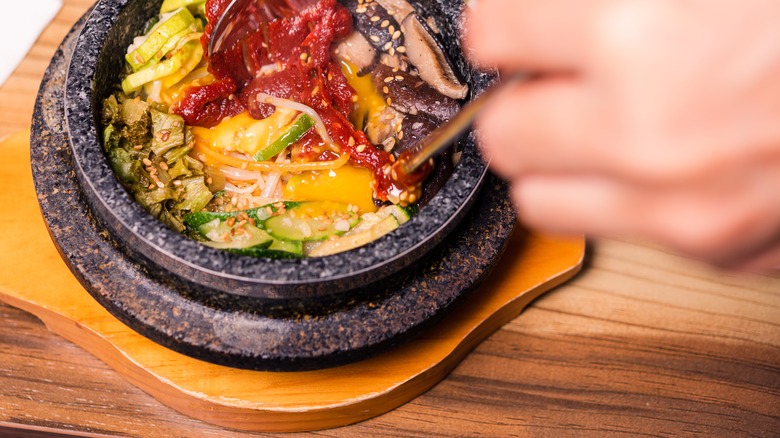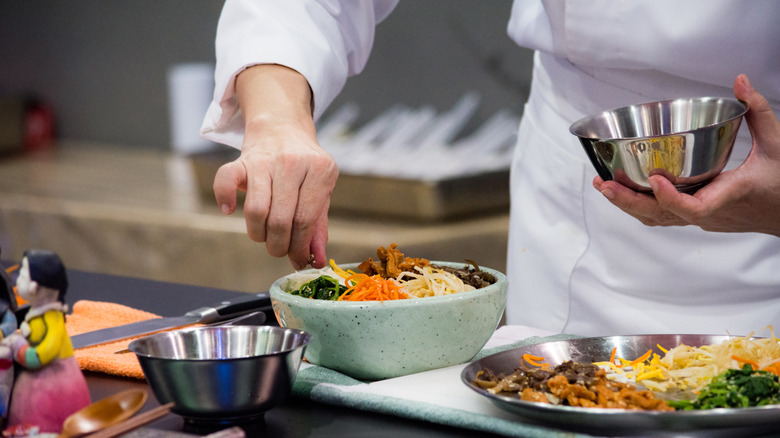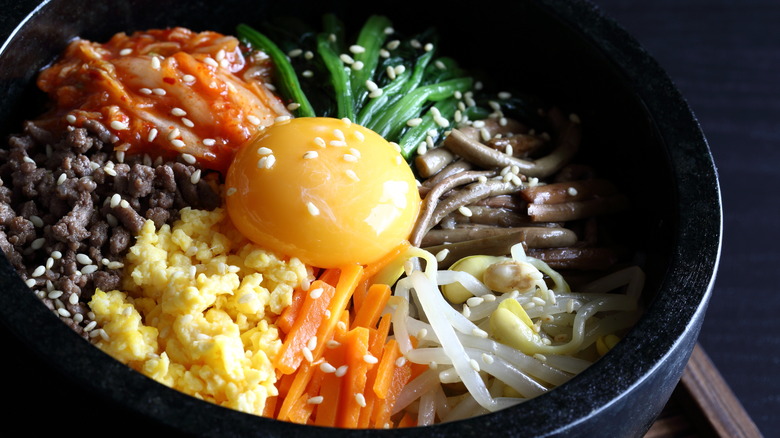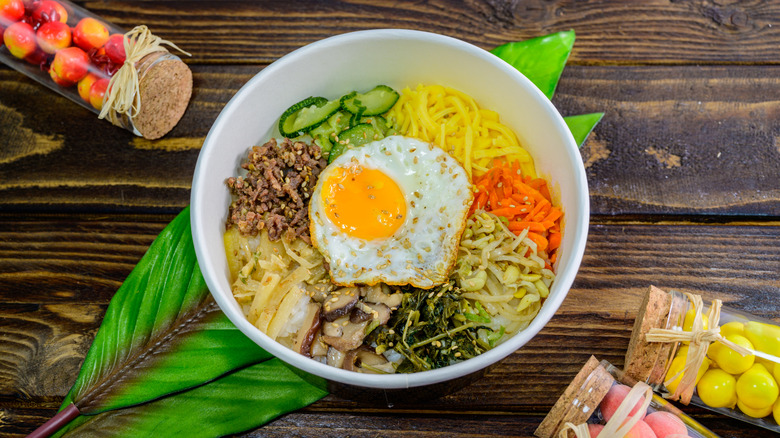The Untold Truth Of Bibimbap
For lovers of Korean cuisine, the classic rice dish bibimbap is comfort in a bowl. Simply defined, it's nothing more than a bowl of hot rice with an assortment of toppings. This may not sound super impressive, but lovers of bibimbap know the whole is more than the sum of its parts. You can't just slop random foodstuffs over a bowl of rice and call it bibimbap — whatever toppings you choose, they have to be attractively arranged. Typically, when you order it, you'll be presented a bowl with a sunny fried egg in the center with colorful bands of toppings radiating from it, along with hot chili paste. It will be almost too pretty to eat — but too tantalizing not to.
Of course, every rice-growing culture has dishes of rice topped with (or mixed with) other things. But besides its eye-catching looks, what makes bibimbap unique — and so beloved by Korean diners — is its versatility. It can be made as fancy or frugal as one wishes — as Fine Dining Lovers notes, cooks top it with everything from leftovers to rare beef. And regional variations abound, each showcasing the natural and agricultural bounty of its place of origin.
Here's what's in bibimbap and how to eat it
While bibimbap has a multitude of variations — and at the end of the day, cooks can make it any way they please — the best-known style (and the type you are most likely to encounter in Korean restaurants in the states) is the Jeonju style, a specialty of the city of Jeonju in the western part of South Korea. It's a colorful and healthful dish, with the rice topped with both fresh vegetables (including bean sprouts, spinach, and carrots), reconstituted and seasoned dried vegetables (specifically fernbrake and bellflower roots), along with beef, a fried egg, and Korean hot pepper paste (gochujang), according to Korean cookbook author Maangchi.
While your bowl of bibimbap will typically be served to you with all its ingredients meticulously arranged in distinct stripes, all the flavors are intended to be enjoyed together. As Maangchi explains, the word "bibimbap" translates literally to "mixed cooked rice," so you're fully expected to destroy the beautiful arrangement in your bowl and mix everything together before digging in. It may not be as pretty — but it will be tasty.
While eaten together, each bibimbap ingredient must be prepared separately — and with care
Part of what makes bibimbap so appealing is that it offers a variety of flavors and textures in each bite. Thus, while all the ingredients in your bowl are meant to be eaten together, they should not look (or taste) alike. This means, as cookbook author Maangchi notes, that while bibimbap is at heart a simple dish, it will take some time and care to put together to get the right flavors and contrasts: Each topping ingredient must be prepared separately, with its own set of seasonings and special cooking method.
In her recipe, for instance, the dried vegetables are first reconstituted in boiling water, then drained and lightly sauteed with garlic and sesame oil. Carrots are simply julienned, salted, then sauteed. Lean beef (filet mignon or flank steak) is cut finely and marinated in garlic, soy sauce, honey, and sesame oil and served raw. And each of the half-dozen or so other toppings gets a similarly individualized treatment. It's definitely a labor of love — but the appetite you work up preparing it will make it even more rewarding to eat and enjoy.
If you crave extra crunch, try dolsot (stone pot) bibimbap
Bibimbap is already a festive-looking dish, but diners who want to take their experience to the next level may choose dolsot bibimbap. "Dolsot" is Korean for "stone pot," and refers to the super-heated stone bowl in which the dish is served. It acts as an individual heating unit, and not only helps keep the bibimbap warm while you eat it, it causes the rice touching the bottom of the bowl to toast and turn golden and crunchy. This crunchy rice crust, a sought-after treat in its own right among Korean diners, adds extra texture and flavor to the already varied dish.
To prepare dolsot bibimbap, cooks lightly grease a heated stone pot with sesame oil before adding the rice and arranging the toppings as usual, according to Kimcheemari. While you can use the same variety of toppings you'd use in regular bibimbap, the extra heat generated by the pot makes dolsot bibimbap a great vehicle for cooked seafood and rich meats such as short ribs. And instead of topping the bowl with a fried egg, it's common to simply crack a raw egg in the stone pot — the heat from the pot will help the egg cook. But to avoid scorching your fingers, remember not to touch the bowl while you're eating!
Bibimbap has a long, but unclear history
While some popular dishes have clear origin stories and even identifiable inventors, the precise origins of bibimbap have engendered a surprising amount of conjecture and debate, according to a study by Kyung Rhan Chung and colleagues published in the Journal of Ethic Foods. Among the theories about the origins of bibimbap, according to Fine Dining Lovers, is that it was first created as a harvest dish, since it could be made in large quantities to feed large numbers of farmworkers, or that it derived from dishes made as ritual offerings for ancestor worship. While Chung and colleagues managed to identify written references to composed dishes of rice, sauce, and vegetables dating back to the 1600s, they argued that because literacy rates were low in Korea at the time — and thus relatively little information about everyday activities got documented — versions of bibimbap may have existed for centuries before that.
Chung and colleagues concluded that bibimbap naturally evolved from the structure of traditional Korean meals, which standardly comprise rice, broth, an assortment of small side dishes, a stew, and sauce, all served at the same time. Bibimbap, they argued, most likely evolved as an efficient way for busy cooks to combine multiple components of a traditional meal into a single dish.
Early versions of bibimbap were traditionally served before the lunar new year
Today, bibimbap is seen as an everyday dish, a popular choice for a casual lunch out or a leisurely dinner to make at home for family. And chances are, the toppings you will have with your rice will have been planned, selected, and prepared in advance. But the flexible nature of bibimbap — historical sources list varieties featuring ingredients ranging from green pumpkin to raw fish to shrimp roe –- means creative cooks have lots of room to improvise: Because there's no single correct combination of toppings for bibimbap, you can make it your own, according to your tastes or what you have on hand.
For this reason, Fine Dining Lovers notes, early versions of bibimbap were associated with Lunar New Year celebration rituals. According to Remitly, Korean tradition (as well as the traditions of China and other Asian countries, according to Nations Online) call for cleaning one's home thoroughly before the new year to eliminate any traces of bad luck from the preceding year. Hence, the days leading up to the new year are a time for clearing out one's kitchen and pantry. And this is where bibimbap comes in: With some care and creativity, those odds and ends in your crisper drawer can make an enticing meal to honor the new year to come.
Bibimbap was a favorite of both upper and lower-class diners
The versatility of bibimbap gives it yet another advantage — it can be (and has been) enjoyed by anyone, regardless of budget. A study in the Journal of Ethnic Foods cites a theory that it was invented by women working on farms, who lacked the time to prepare traditional multicourse meals for their families. As mentioned, because it was also believed to be a popular harvest meal for feeding large numbers of hungry people easily, it could have been considered a working-class shortcut meal. Potentially a quite affordable one too, if made with readily available ingredients.
But historically, bibimbap also developed a veneer of luxury. The Journal of Ethnic Foods study cites a report that bibimbap was historically prepared and served to government officials and other honored dignitaries and was a popular dish among the wealthy. And today, some versions of bibimbap feature luxurious ingredients such as filet mignon, and as noted by Eater, a reimagined, modernized version including rare tuna and preserved lemon is offered at the Michelin-starred Chicago restaurant Parachute.
Bibimbap is traditionally served with a light broth on the side
Traditional Korean meals typically include a light, brothy soup, according to a study in the Journal of Ethnic Foods. And while bibimbap is often seen as a self-contained meal in a bowl, by tradition, some versions are also served with a brothy soup on the side. In her recipe for what she describes as typical restaurant-type bibimbap, for instance, cookbook author Maangchi ingeniously cooks bean sprouts in salted water, then removes and seasons some of the sprouts for use as a topping while reserving the water and the remaining cooked sprouts to serve as the accompanying soup.
Upon reading the recipe, some may think of a simple mixture of water, salt, and bean sprouts as a bit bland for a first or side course. But according to the study in the Journal of Ethnic Foods, this simple soup was not intended to be experienced as a stand-alone dish. Instead, it helps with swallowing the other ingredients in the bowl in addition to aiding in the digestion of the rice. In other words, its simplicity is a feature, not a bug.
One popular regional bibimbap variation originated on the battlefield
We've all heard the old saying "necessity is the mother of invention" — and nowhere is this more true than in the kitchen. Every day, busy cooks around the world put together new twists on favorite dishes using the ingredients and time they have, maybe substituting or leaving out expected ingredients or conflating cooking steps.
And crisis situations demand even more creativity and ingenuity from cooks — how do you keep those close to you properly nourished when all hell is breaking loose around you and a last-minute trip to the supermarket isn't possible? During Japan's invasion of Korea, in the Battle of Jinjuseong in 1593, cooks responsible for feeding the Korean troops didn't have much time to prepare their meals, nor did the troops have much time to eat them. The cooks' solution, per Kworld Now, was a variation of bibimbap featuring seasonal vegetables and raw beef. It hit all the right notes: It was fast to cook, featured readily available ingredients, could be eaten quickly, and was both flavorful and nourishing. Now known as Jinju bibimbap, this dish is a regional specialty of the city of Jinju, the site of the original invasion and battle.
Bibimbap and other Korean dishes have become trendy in India
As reported by Marketplace, Korean culture is having a moment — global audiences are falling hard for everything Korean, from skincare products to the stunning transformation of BTS to "Squid Game." As the South China Morning Post notes, Korean dramas are hugely popular in India, and Indian viewers seeing the mouthwatering food enjoyed on their favorite K-dramas can't help wondering what these dishes are, what's in them, and how they can try some too. This has led to a proliferation of Korean restaurants in India and the rising popularity of Korean dishes such as bibimbap, especially among young people.
"It is a yummy dish made from sticky rice and topped with meat, spinach, carrots, bean sprouts and kimchi. Everything is combined with sesame oil and spicy red pepper paste called gochujang," a bibimbap-loving New Delhi woman told South China Morning Post. "I loved its look so much that I learnt to make it from a YouTube video and now often invite my friends over to enjoy it with them." And while excitingly novel for Indian diners in some ways, Korean food is also comfortingly familiar in others. "Both Indian and Korean incorporate many similar ingredients like rice, vegetables, meat, chili, pepper and spices," Akshay Bhardwaj, head chef at Andaz Hotel, New Delhi, said. With dishes like kimchi being similar in flavor to Indian pickles, it's not surprising the dish plays well with the palates of Indian diners.
When flying to or from Korea, you might get bibimbap for dinner
Bibimbap has become such a powerful emblem of Korean cuisine that if you're traveling to Korea, you may be offered your first taste of it before you even arrive. In 1997, Korean Airlines introduced bibimbap to its inflight meal lineup. It not only became a hit with hungry flyers, but earned Korean Airlines the Mercury Award from the International Flight Catering Association, according to The Korean Times. And since then, other airlines have followed their lead, with Delta and Singapore Airlines (among others) offering their own versions of bibimbap on flights to and from Korea.
While in-flight bibimbap is definitely a big step up from the cold sandwiches and rubber chicken you may expect from standard airline food, you should still keep your expectations in check. Because of the logistical constraints of preparing and storing inflight meals, you won't get that freshly fried (or just-cracked raw) egg in the middle of your toppings. And as a photo on Korean Airlines' website suggests, your toppings may come in a separate bowl from your rice. And the gochujang (red chili paste) that traditionally accompanies bibimbap will also be presented separately, in what looks like a travel-sized toothpaste tube.
Bibimbap exemplifies the Korean philosophy towards food
One of the fun things about exploring the cuisines of different cultures is the opportunity to learn by tasting — every dish tells you something about the physical environment and society that shaped it. And according to the Washington Post, bibimbap exemplifies the core values of Korean food culture. Most prominent among these values is the notion of nature and time. This means seasonal ingredients are celebrated and enjoyed fresh when available, but traditionally preserved foods (such as prepared sauces and dried vegetables) are enjoyed year-round. Another core value is balance — offering meals that offer both balanced nutrition and a balance of flavors, colors, and textures. As the Washington Post notes, bibimbap clearly reflects these values, with its combination of fresh and preserved ingredients, visual and textural appeal, and healthful portions of protein, carbohydrates, and fiber served together.
In addition, as Korea.net reports, the attractive colors of well-prepared bibimbap aren't just for visual balance. The five colors that typically appear in a bowl of bibimbap (green, red, yellow, white, and black) are those traditionally associated with the five basic elements posited in East Asian philosophy (wood, fire, earth, metal, and water). So by tradition, incorporating these colors, and thus their corresponding elements, into your meal will ensure you have not only an enjoyable dining experience, but a healthful one as well.
The appearance of instant bibimbap on a Korean drama sparked a scandal
Bibimbap has long been a popular meal in Korea, so it's not surprising for viewers of Korean dramas to see their favorite characters enjoying it. But when viewers of the popular K-drama "Vincenzo" depicted its two leading characters eating bowls of instant bibimbap (yes, that's a thing) together, viewers were outraged, and a scandal erupted. As reported by the South China Morning Post, the fact that it was instant bibimbap wasn't the problem. The true scandal, as far as many viewers were concerned, was that it was made by Zihaiguo, a Chinese company that also happened to be a sponsor of the show.
The sponsor's attempt at product placement had the exact opposite effect than it probably wanted. Fans of the show accused the Chinese company of stealing (or at least appropriating) their cultural heritage. "What is this Chinese bibimbap product placement? Now they [the Chinese] are going to argue that bibimbap is a Chinese dish," one online commenter wrote. Another commenter saw the problem from a different angle. "If the network just sells placement to Chinese companies for quick money, wouldn't [foreign] people who watch this series think bibimbap's Chinese food? This is a serious issue ... I know money is important but this is taking it too far."
